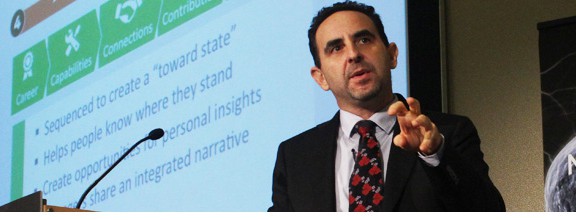
Dr. Relly Nadler: This week we are going to interview David Rock and we are going to talk about the Biases and Beyond Bias. David has really brought neuroscience to the corporate world. We will ask David how that came about and some questions about organizational bias. Let me just give you and overview about what we are going to talk about today.
We are in this hyper-connected world. Poor decisions can multiply like a chain reaction. Breaking free of bias has never been more important. Many of the organizations are putting money and resources towards educating people about biases. For example, US companies spend an estimated $200 – $300 M a year on diversity programs, sensitivity training in which executives, managers and employees are told to watch out for biases, in particular, when making hiring and promotion decisions.
Unfortunately, there is very little evidence that educating people about biases does anything to reduce their influence. Human biases occur outside of the conscious awareness and thus people are literally unaware of them as they occur. So, Dr. David Rock today is going to tell us more about breaking bias to maximize talent.
Dr. Cathy Greenberg: I am super excited to have David Rock with us today. As you know, we were with David in New York when he launched his fabulous Neuroleadership Summit which has remained one of our favorite places to go on the science of the brain.
Dr. Relly Nadler: So since the mid-90s, David has trained over 10,000 executives and personal workplace coaches in more than 64 countries. He has a few different books: Quiet Leadership, With the Brain in Mind and Your Brain at Work: Strategies for Overcoming Distraction, Regaining Focus, and Working Smarter All Day Long. He is a guest lecturer at Universities around the globe including Oxford University Said Business School. He has a professional doctorate in neuroscience leadership from Middlesex University in the UK, and he lives in New York with his wife and two young daughters.
Tell us a little bit about, I remember when we’ve interviewed you before they call you the neurotransmitter. I’m always intrigued about how your interest in neuroscience come about, and then the Neuroleadership Institute, and everything else you do. Then we’ll get into bias.
Dr. David Rock: I have been involved in developing leaders and building leadership development programs for a long, long time; around 18 years. All the way through I had a personal interest in the brain. I had been reading and studying personally about the brain but never connected them. At some point, about 12 years ago now, I started to just include a few snippets about how the brain works in various programs I was running for coaches and for leaders. I just found people had tremendous insight at a much deeper level about what we were teaching them, whether we were teaching building trust, or developing teams, or influence people, whatever it was.
When we were actually able to explain from authentic science of what really happens in the brain, people really got the ideas much better. It wasn’t just a marketing thing, or it wasn’t just filling seats and it wasn’t just that they believed what we were saying, it’s that they actually understood the, literally, the building blocks of the muscles necessary to be better as leaders. They really saw how they needed to change that much more crisply and clearly.
I set off to see if there was a way to build tools and insights from neuroscience. I was really thinking about it from about 2002-3, but 2007 I pulled together the first conference called The First Neuroleadership Summit. I think we had 50 people there. This year we will have about 700 in a big, big venue in New York City in Times Square, and probably between 20,000 and 30,000 this year we are expecting to log in and watch, as well, in real time, which people can do free.
So what we have been doing since 2007 is really building a whole language for how to be a better leader that is being used by well over 1,000 organizations, which have been impacted and using this. We started a movement around doing performance management without ratings. We started a whole movement on how to rethink learning and now we are starting a movement in a really different way of attacking bias and inclusion as well, which we can talk about.
Essentially, we have a team of scientists and we organize and synthesize all this really important science coming out so that organizations can actually use it to make people better; that’s basically what we do.
You can listen to this fascinating discussion, above!
Relly

